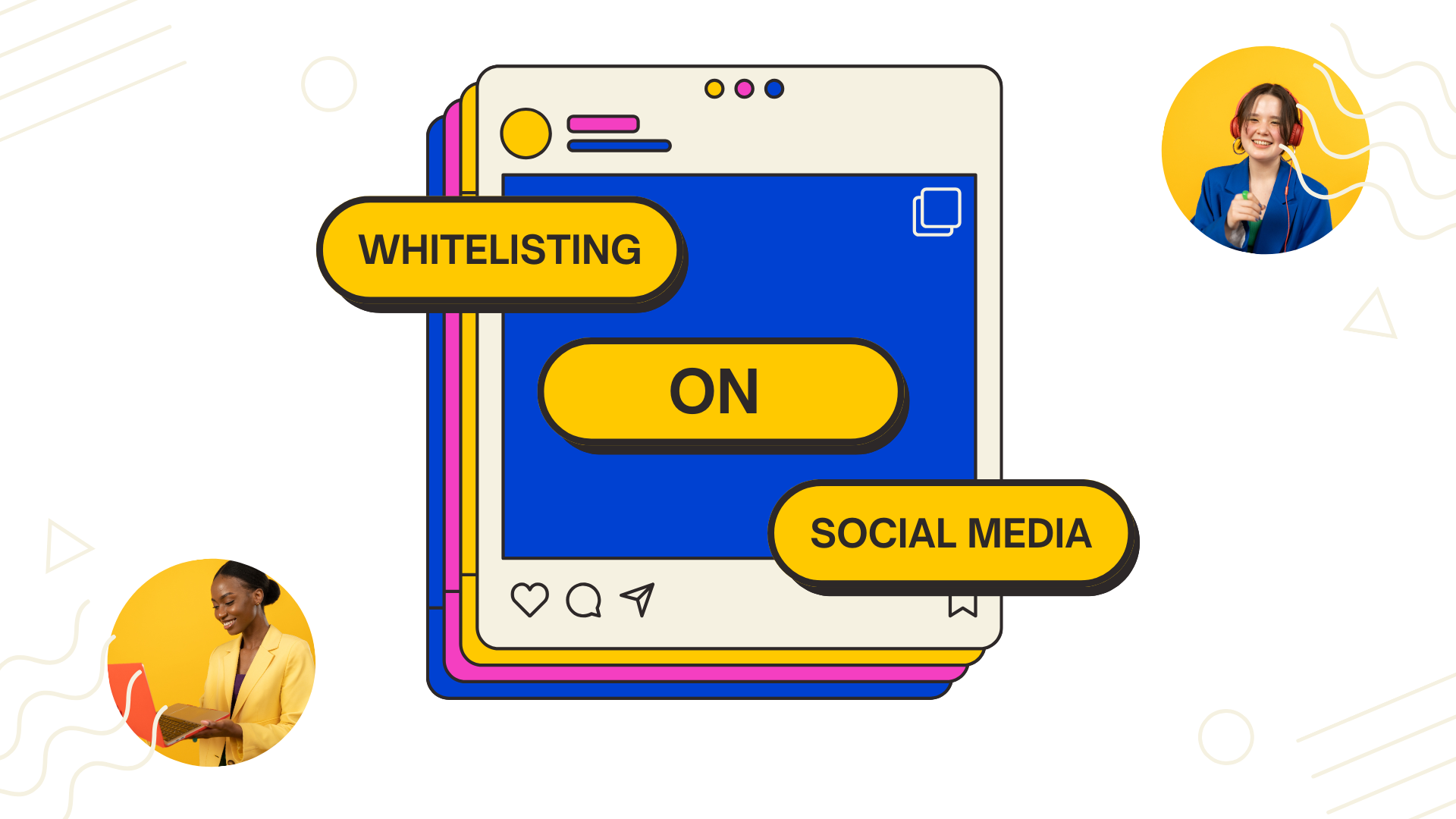Maybe you recently read an article or chatted with a colleague and heard about whitelisting on Instagram or TikTok…
If you’re used to hearing the word “whitelisting” refer to cybersecurity maneuvers or email inboxes, you might’ve thought, “What is whitelisting in social media? What does it MEAN?”
Hold on, because we’re about to rock your world. 😉
If you’re a brand looking to expand your reach– or an influencer looking to add passive income to your portfolio– keep reading! In this article, you’ll learn what whitelisting on social media means, plus the benefits for both brands and creators.
What is whitelisting in social media?

Whitelisting in social media (aka influencer whitelisting) happens when an influencer gives a brand access to their social media accounts (TikTok, Instagram, or Facebook) to run paid ad campaigns for their products.
Think about it this way: if you have a social media account, you can give brands access to it and they can run ads through it. They pay you just for access to your ads account. Easy, right?
And we’re not talking about giving them enough access to boost posts. For it to truly be whitelisting, the brand needs full access to the creator’s account, including their Business assets and Ads Manager to start running full ad campaigns.
If you’re asking, “Why would anyone want to do that?” just know this: Whitelisting in social media has become popular because there are many benefits for both brands and creators. Let’s look at those now.
What are the benefits of influencer whitelisting for brands?

First, let’s talk about the benefits of whitelisting for brands:
Increased reach and brand exposure
By running ads through accounts you don’t own, you increase the chances of reaching new audiences that might never be available through your brand’s accounts.
This is a huge benefit, especially if you’re trying to grow.
Access to metrics
When you have full access to an influencer’s profile, you also have access to all of their metrics and insights– which can be a GOLD MINE for learning about your audience.
It’ll also help you figure out what kinds of influencers will be most effective to work with in the future because you’ll see first-hand how their audiences respond to your ads.
More sales
Because you’re running ads to new audiences, you’re increasing your chances of generating more sales. It’s not guaranteed, but getting your brand in front of more people puts the odds in your favor.
Things to watch for
There aren’t any major disadvantages to whitelisting ads for your brand, but there are a couple of things you need to know:
First, getting access to different accounts on Meta and TikTok can be… A process. Social media ad platforms are complicated, so be ready to take a few hours to wrap your head around the labyrinth of someone else’s ad account.
Second, pay attention to your budget– running ads through additional accounts does mean you’re spending more money. Monitor your ROAS and you should be just fine.
What are the benefits of whitelisting for creators?

Now that we’ve covered how whitelisting in social media benefits brands, let’s talk about how it benefits creators, too.
Revenue that requires little to no work
Granting brands access to run ads through your account doesn’t require much work. It’s a one-time process, then the brands take care of the rest. In exchange, you can get a cut of the monthly ad spend or a fixed monthly fee, whatever you and the brand decide.
This all depends on the brand’s size, budget, and what you negotiate with them, of course. But if a brand wants to whitelist your social media account, it’s free income. So that’s awesome!
Growth opportunities
When your account runs ads, you’ll be pushed in front of more people. This means more followers, more engagement, and more brand opportunities. (Yes, even on the organic side of your account!)
With whitelisting, you get the benefits of growing your account with ads, without having to spend money. You’ll be paid for something that grows your following.
Things to watch for
If you’re considering whitelisting your account, make sure the ads that the brands run through your account do not promote products that are misleading or that don’t offer value.
You should be safe if you only whitelist with brands you genuinely trust and whose products you believe add value. But if you don’t think it adds value, why would you let them use your account? That’s just going to erode trust with your followers.
Second, while reaching new audiences is great, be warned that greater exposure also means trolls can more easily find your account. Expect negative engagement to come with your greater reach.
If you’ve never run ads before, this can be a shock. We promise it’s not you. It’s a normal (albeit unpleasant) part of growing your social media following.
How much should brands pay influencers or creators for whitelisting?
While this ultimately depends on the influencer, it can potentially go two ways:
- A percentage of the total monthly ad spend. For example, if a brand spends $2,000 on ads in a month, 10% goes to the creator. You need to negotiate this rate beforehand.
- A fixed fee. This monthly fee can vary depending on the account you run ads through. Their follower count, engagement rate, campaign duration, and overall metrics like reach and impressions affect the price.
Whether you’re a brand or an influencer, do your research ahead of time so you know what to expect and can come to an agreement.
Is whitelisting on social media the right strategy for your brand?
This is the big question: Is whitelisting on social media the right strategy for your brand?
In our opinion, your brand should meet the following criteria to whitelist:
- The budget. You’ll need to dedicate a specific budget for this on top of your current ad spend. Is your cash flow steady enough to support more spending? Sure, sales will come from this experiment, but you don’t know how much they’ll cost.
Side note: If you aren’t running ads through your accounts yet, forget about whitelisting. First, start running ads through your accounts, learn how to do it, and then start whitelisting.
- The creative. Running ads through new accounts requires more creative assets (aka images and videos). Influencers can provide some, but you’ll need to have several options so you can experiment and see what works with this account’s audience.
- The copywriting. It’s a nice idea to use new copy here– it is a new audience, after all! It’s also fine to use copy that performs for you already. Just keep in mind that you’ll need to have something to write for those ads.
What results can brands expect from whitelisting in social media?
Is whitelisting worth it? What results can you expect?

The answer: It depends.
You can expect greater brand awareness and increased reach, no matter what.
However, if you’re looking for guaranteed sales, you may be disappointed. The Meta algorithm (not to mention TikTok) is too unpredictable to have any solid predictions for a new ads account– you’ll have to experiment, see what works, and do more of that.
With that in mind, here’s our advice: Take things slow. Start with a small budget, and A/B test to see what’s working and what isn’t. Then, scale like you would with your account.
Whitelisting is a great strategy, but it’s not a magic sale-increasing formula. Like anything else, it’s wisest to start small and scale.
Table of content
- What is whitelisting in social media?
- What are the benefits of influencer whitelisting for brands?
- What are the benefits of whitelisting for creators?
- How much should brands pay influencers or creators for whitelisting?
- Is whitelisting on social media the right strategy for your brand?
- What results can brands expect from whitelisting in social media?
Looking for UGC Videos?
Table of content
- What is whitelisting in social media?
- What are the benefits of influencer whitelisting for brands?
- What are the benefits of whitelisting for creators?
- How much should brands pay influencers or creators for whitelisting?
- Is whitelisting on social media the right strategy for your brand?
- What results can brands expect from whitelisting in social media?







